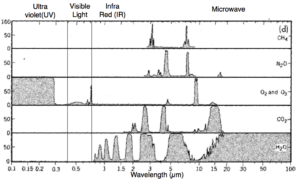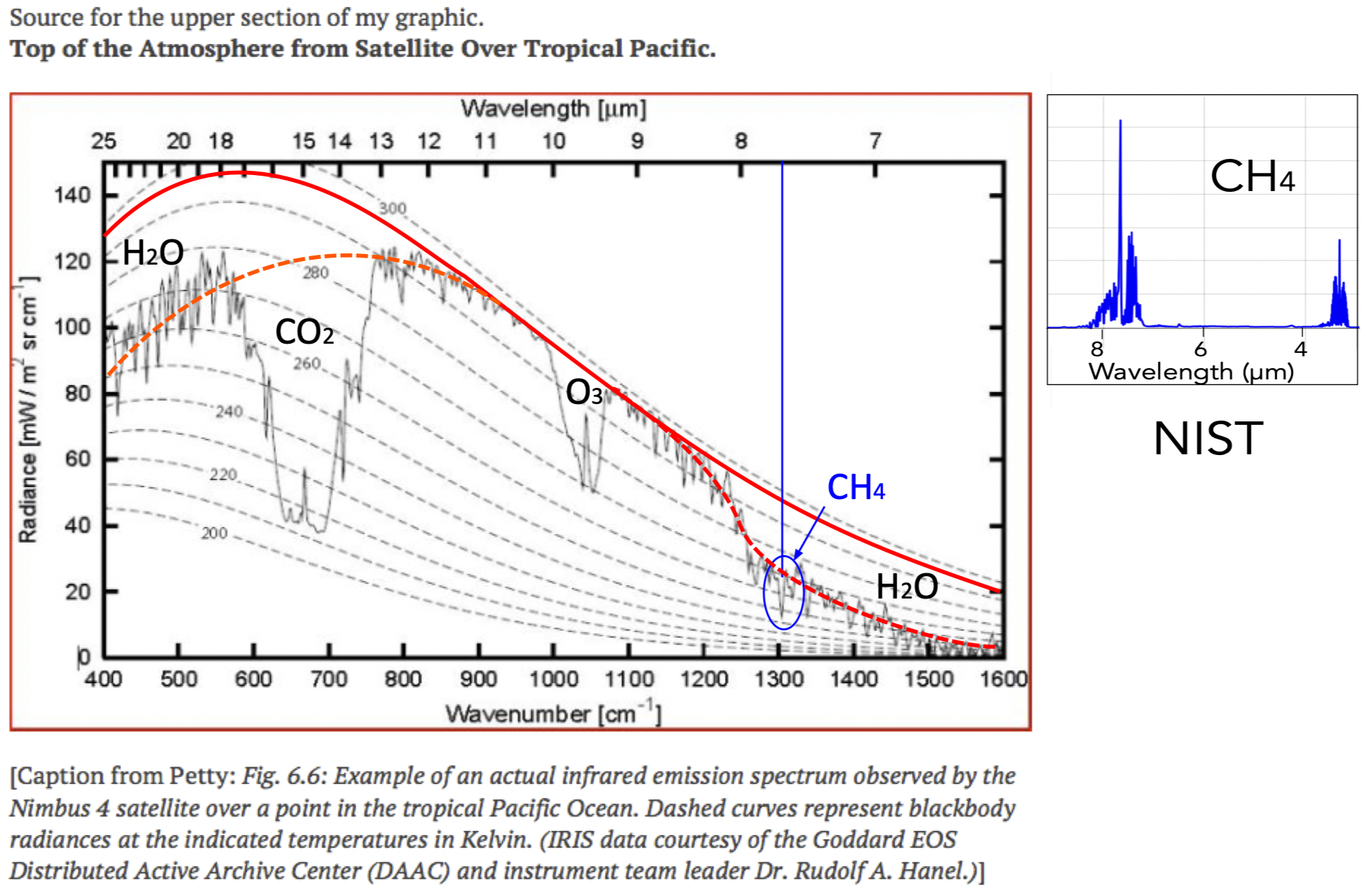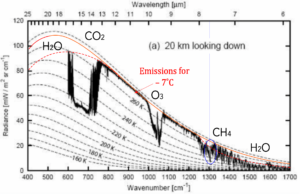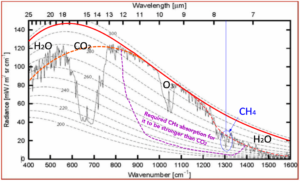Methane as a Greenhouse Gas
Abstract
Methane (CH4) is presented as a powerful greenhouse that has over 25 times the global warming potential of carbon dioxide (CO2). Cutting methane emissions by cattle and other farm animals is requested as a way to reduce global warming. This presentation shows that methane’s role in raising global temperatures is not detectable.
Introduction
Greenhouse gases have the ability to absorb and radiate heat, but only at specific wavelengths. Figure 1 shows the absorption spectra of the naturally occurring greenhouse gases. Molecules from each gas can only capture heat that has the wavelengths shown in their spectrum. The two gases that absorb the largest amount of heat are water vapour (H2O) and carbon dioxide. Methane only absorbs across a very small wavelength range.

Figure 1 The absorption spectra of different greenhouse gases.
Carbon dioxide’s atmospheric concentration is currently 420 parts per million (ppm), 0.042%. That of methane is 1.9 ppm, 0.00019%. Methane’s presence in the atmosphere is less than 1/200th that of CO2. The comment: “Methane is more than 25 times as potent as carbon dioxide at trapping heat in the atmosphere” [1] is often used in environment literature. Its validity can be checked by looking at some measured spectra.
Results
Figure 2 shows a spectrum taken by Nimbus 4 satellite over the tropical Pacific Ocean. The absorption bands for the various gases are labelled. The horizontal axis is wavelength. The vertical axis is heat power. The dotted lines indicate the power that would be emitted at the wavelengths and temperatures indicated.
Figure 1 shows there is almost no absorption between wavelengths of 8 to 9 µm and 10 to 12 µm. Radiation emitted from the ocean’s surface will be detected at the ocean’s surface temperature, namely 24˚C. The red line shows the spectrum that would be detected if there were no greenhouse gases in the atmosphere.

Figure 2 A spectrum of radiation detected over the tropical Pacific Ocean.
Greenhouse gases work by capturing heat radiated from the surface. Some of the heat is radiated down, helping to warm the planet. Some is radiated up, where it can be captured by molecules higher up. That heat is also radiated up and down. Eventually a stage is reached where there are no more molecules above to capture the heat. Those upper molecules radiate their heat into space. That is the spectrum captured by the satellite. The absorption bands for the different gases are labelled.
The regions of the spectrum below that line show where the labelled gases have absorbed some of the heat and warmed the atmosphere. At each wavelength, the amount of heat absorbed is proportional to the distance below the solid red line.
Water vapour overlaps some of those absorption bands. It will absorb the heat radiation whether or not there were other greenhouse gases present. The dashed red line shows the average that water vapour absorbs. The amount of heat the other gases contribute to the planet’s warming is proportional to the spectrum’s area below the dashed red line.
The inset shows details of methane’s spectrum. It was measured by the US National Institute of Standards and Testing. It shows that methane’s has a peak at a wavelength of 7.7 µm. The line from the wavelength scale shows a little region outlined in blue. It is methane’s absorption contribution to warming. It is a lot smaller than carbon dioxide’s contribution. Methane’s 3.6 µm peak is off the scale, where the heat absorption is much lower. It is completely covered by water vapour’s absorption. It has no role in absorbing heat.
At wave lengths longer than 25 µm, water vapors absorbs all wavelengths. Wavelengths shorter than 6 µm have very little energy. Gases that absorb in those regions have very little heat to absorb. Unless a gas makes a detectable absorption in this 6 to 25 micron wavelength band, it is not making a detectable difference to average global temperature.
That shows the situation over the tropics. Figure 3 shows a spectrum measured over the Arctic. The ice’s surface temperature was ≈ – 7˚C. It also shows that carbon dioxide’s contribution is much larger than is that of methane. The same absorption principles shown in figure 2 apply. Methane’s peak is only just detectable above water vapor’s noise fluctuations.
Averaging between the tropical and Arctic spectra show that water vapour is responsible for about 75% of warming, carbon dioxide for about 24%, ozone for about 1%. Methane’s contribution is less than 0.001%.

Figure 3 A spectrum of radiation detected over the Arctic.
Discussion on Methane In total, methane absorbs ≈ 1/3000th that of carbon dioxide. Methane’s concentration to Earth’s atmosphere is less than 1/200th that of carbon dioxide. Each methane molecule absorbs about 1/15th that of each carbon dioxide molecule. That is about what would be expected by comparing the methane and carbon dioxide spectra in figures 1 and 2.
Greenhouse gas potency is expressed relative to carbon dioxide being equated to 1. Methane lasts for about 10 years before being changed to carbon dioxide. During that time its potency per molecule is about 0.06%. After 10 years, its potency becomes the same as carbon dioxide, namely 1. If carbon dioxide lasts in the atmosphere for 100 years, methane’s total potency becomes 1.006 times that of carbon dioxide. For all practical purposes their potencies are the same.
From the above, there is no physical means to make methane a more powerful gas than carbon dioxide. However, it is necessary to explain why methane is regarded as a much stronger greenhouse gas than carbon dioxide. Among the reasons given is: “Methane absorption happens to sit in some of these areas where the atmosphere isn’t doing a lot of absorption of energy as it goes” [2]. Figure 1 shows that methane’s two absorption bands are overlapped by water vapour.
But that isn’t the end of the story. Observations have shown that, when greenhouse gases are mixed with other gases, absorption in other wavelengths are possible. As a well mixed greenhouse gas (WMGHG) methane has high absorption in the 0.5 µm to 2.0 µm wavelength range [4]. That corresponds to the red to near infrared range. Although there is some water vapour in that wavelength range, it is not saturated. On top of that, the sun’s energy input in that wavelength range is much higher than the energy radiated from Earth. With its high absorption of high intensity radiation directly from the sun, methane absorbs a lot of heat directly from the sun. That heat goes directly into the atmosphere.
For its time in the atmosphere, maximum of 20 years, methane molecules do absorb a lot more heat than carbon dioxide molecules. That appears to explain the origins of: “Over the first two decades after its release, methane is more than 80 times more potent than carbon dioxide in terms of warming ..” [3]. That part is mostly correct. That sentence ends with .. “the climate system”. In its totality, the whole sentence is wrong.
The heat that methane’s WMGHG absorbs is heat that is incoming from the sun. It will be absorbed anyway, be it by the oceans, desert sands, grasslands, forests or even solar panels. Once absorbed, it will be radiated in all directions. It doesn’t make any difference whether it is captured at ground level or up in the atmosphere. The heat captured in the atmosphere is radiated in all directions. Some goes down to sea and ground levels, some goes up. It is only the heat that is captured when radiated up that warms the planet.
General consensus is that WMGHG methane acts like a blanket by capturing heat. It only acts like a blanket if it captures the heat from the warm body below it, preventing it from escaping. The power Earth radiates in the 0.5 µm to 2 µm wavelength band is so small there is virtually nothing to absorb on the way out. Earth reflects about one third of the reduced radiation that made its way past that bandwidth range. Some of that will be absorbed. The overall effect prevents more heat reaching Earth’s surface than it stops from leaving Earth’s surface. It does not warm the planet. Figures 1, 2 and 3 combine to show that methane is not stopping the great majority of heat Earth emits from escaping into space. The only contribution that methane makes to warming the planet is that small amount enclosed by the ovals in figures 2 and 3.
If methane was a stronger radiation absorber of heat leaving Earth, it would require an absorption band much larger than the purple curve in figure 4. The non-linear wavelength scale shows the purple curve’s absorption band spread over 5 microns from 7 to 12 microns. Carbon dioxide’s absorption band extends 4 microns from 13 to 17 microns. Even if that absorption band was detected and attributed to methane it would only give methane about the same heat capture as carbon dioxide. There is no indication of that purple curve, or anything like it being detected. There simply isn’t enough spare radiation emitted from earth for methane to absorb 25 times as much radiation as that absorbed by carbon dioxide. That suggestion is just another one of a long list of models where mathematicians have got it wrong.

Figure 4 A required methane absorption spectrum for it to be stronger than carbon dioxide.
An atmospheric greenhouse gas that captures high energy radiation on the way in from the sun, acts like an insulator. Less heat makes its way to the lower levels. Any theory that suggests a different outcome must show up in the equivalents of figures 1, 2 and 3. They are facts to which any theory must fit.
Effect on Pastoral and Agriculture
The above shows that methane’s global warming potential is almost indistinguishable from that of carbon dioxide. It has no additional effect in its own right. With that knowledge, it is time to consider cattle’s contribution to global warming. Cattle numbers have remained constant at ≈ 1 billion for the past decade. Methane remains in the atmosphere for about 10 years. Today’s cattle are replacing the oxidized methane emitted by cattle a decade ago. Cattle are not responsible for any methane increase in the atmosphere. The methane they release per year is about 1% of the total methane in the atmosphere.
Methane’s per molecule contribution to global warming potential to ≈ 1.006 that of carbon dioxide. Suggestions that methane has a global warming potential 25 or 80 times that of carbon dioxide are wrong. There are no absorption peaks to support the idea. The heat that methane absorbs is incoming heat that will be absorbed anyway!
Mitloehner, UC Davis [5], pointed out that methane emitted by cattle comes from grass recently grown from carbon dioxide in the atmosphere. Cattle eat the grass. Some is converted to body mass, some to methane and some is breathed out as carbon dioxide. They emit less methane and carbon dioxide than the carbon dioxide used in making the grass. The rest contributes to their body mass. The methane breaks down to carbon dioxide without absorbing any noticeable heat. Cattle’s net contribution removes carbon dioxide from the atmosphere. At the end of life of both the cattle and consumer, all the carbon dioxide that was taken from the air to form the grass, is returned to the air, either by cremation or decay. In that way, the cattle industry is carbon dioxide neutral.
The same applies for agricultural methane sources. Whether it is fermenting manure or decaying vegetation in rice paddy fields, all the material generating methane comes from recently photosynthesized carbon dioxide. When all is over, their total contribution returns the same amount of carbon dioxide to the atmosphere that was removed to start the process.
Human related activities such as food, rubbish tips, sewage treatment plants, decaying vegetation from farming, and similar, are carbon dioxide neutral. The raw material that can break down to methane and/or carbon dioxide started out as atmospheric carbon dioxide in the not too distant past. No matter what path is followed, it all reverts back to carbon dioxide. Except for power and heat, these industries don’t produce any more carbon dioxide than was originally taken out of the atmosphere.
Comments
The above is not a theory. It is a presentation of the observations and measurements of others put together in a common sense manner. Despite that, climate zealots are requesting actions be taken to reduce methane emissions from cattle. Taxes on cattle are suggested. Such is the level of (mis)understanding of methane’s contribution, that recommendations are forward to tax an industry that is already carbon dioxide neutral, with no deleterious warming effects. The measurements in figures 2 and 3, which are typical for these spectra, show methane has a is negligible role in heat capture that increase average global temperature.
Of all of the world’s major industries, the agricultural and pastoral industries’ products have always been carbon dioxide and global temperature increase neutral. Yet, for some reason, “experts” want to tax these industries that are already fully compliant with requirements.
Some could be forgiven for thinking that the “experts” do not have a good understanding of their topic. To remove any doubt, they should present their theories in an easy to understand manner.
About the Author Those interested in my maths and physics skills are referred to my paper: “Physical explanations of Einstein’s gravity” (https://doi.org/10.1088/2399-6528/abee2f. Einstein’s gravity was regarded as one of the most difficult topics in physics and maths. In it I explained the physics that underpins his calculations; pointed out some physics and maths errors the “experts” made because they couldn’t follow his simple maths; and greatly simplified the calculations. Those errors mean that some of those “experts” predictions are totally removed from reality.
If those “experts” can make such errors, it suggests topics by lesser skilled practitioners may also be subject to similar errors. Climate science predictions should be subject to scrutiny to show its “experts” have not omitted any factors or displayed bias that affects the outcome of their predictions.
References:
[1] https://www.epa.gov/gmi/importance-methane
[2] https://www.alleghenyfront.org/why-methane-is-such-a-potent-greenhouse-gas/
[3] https://earth.stanford.edu/news/methane-and-climate-change